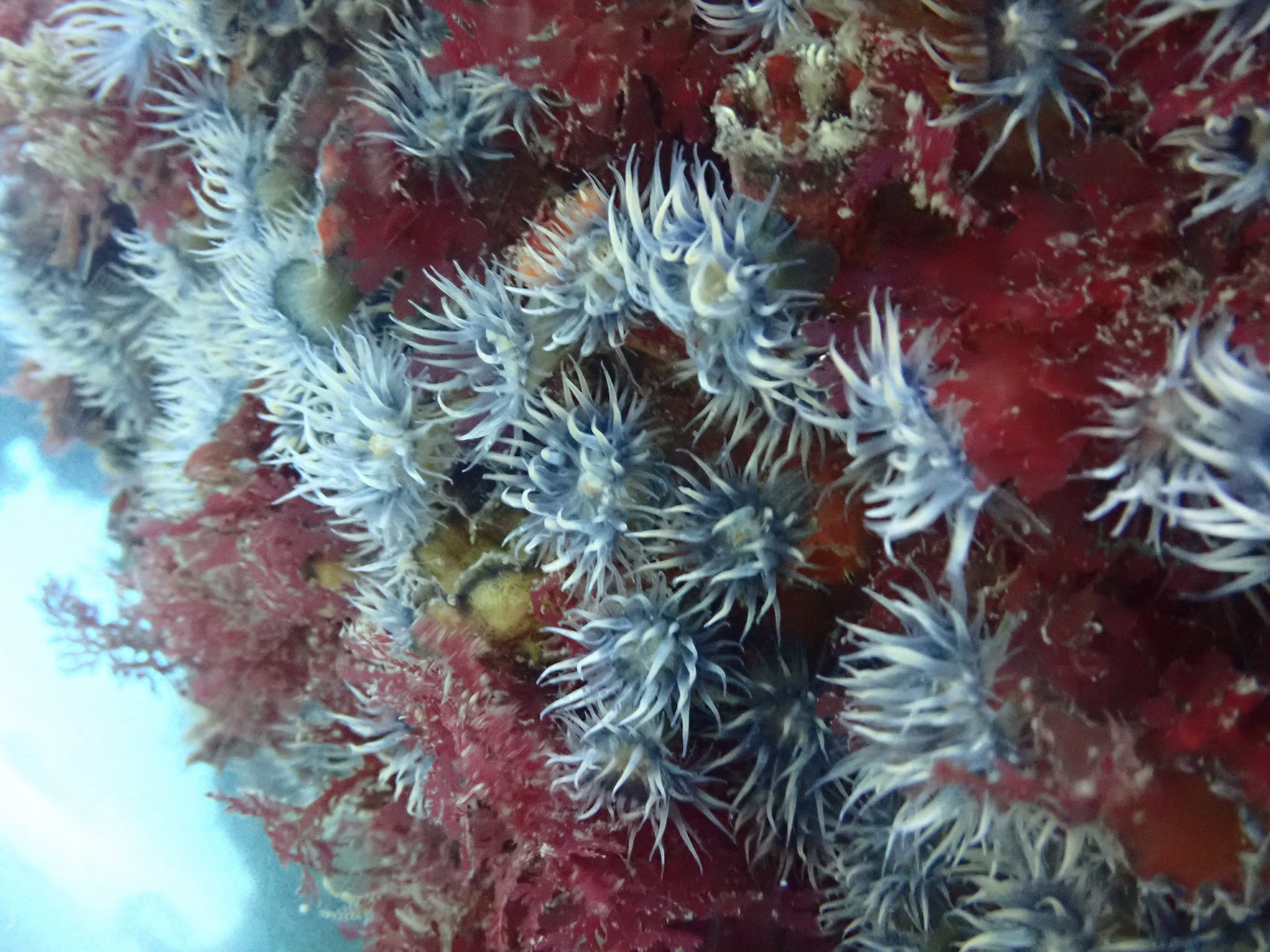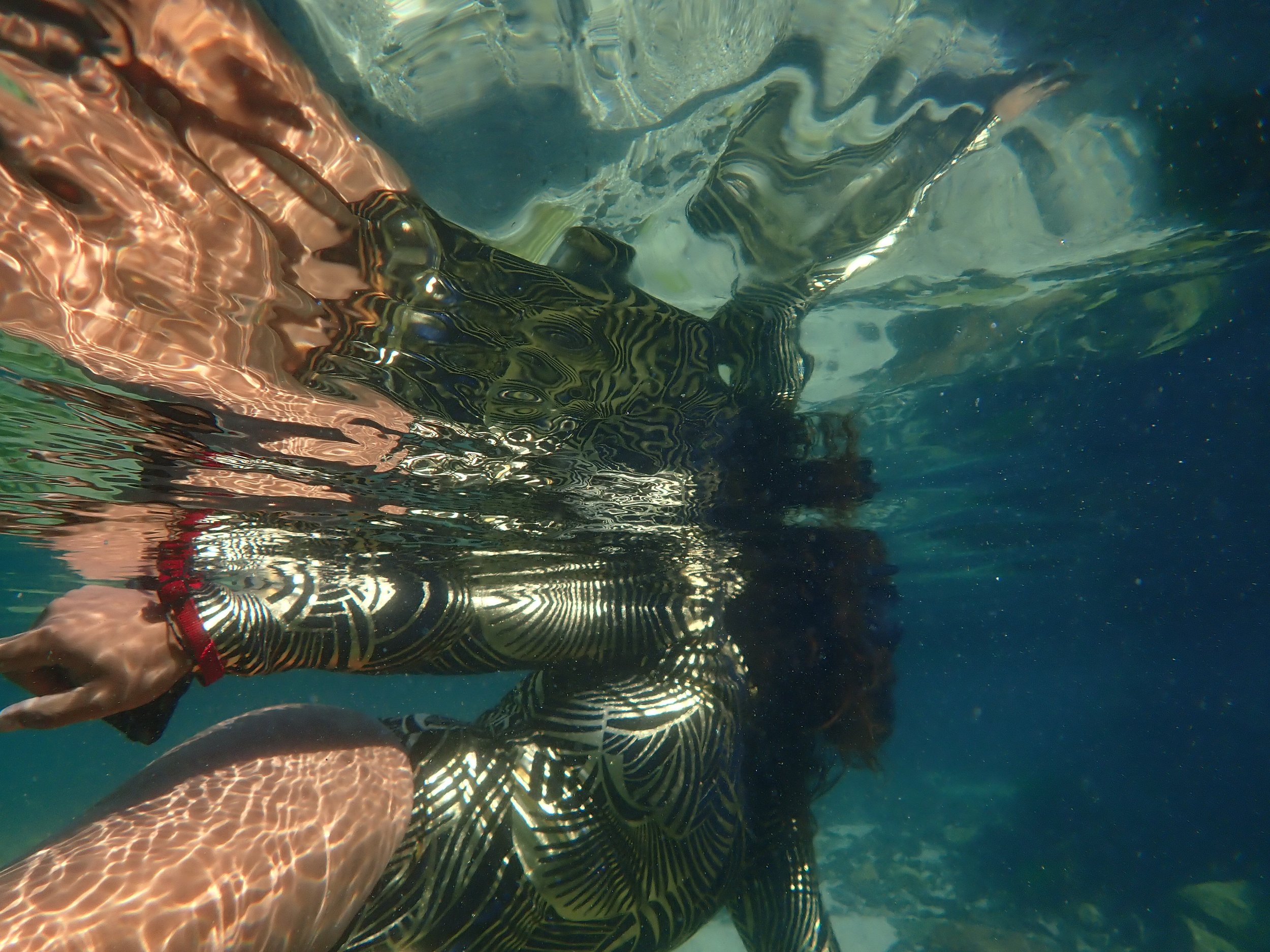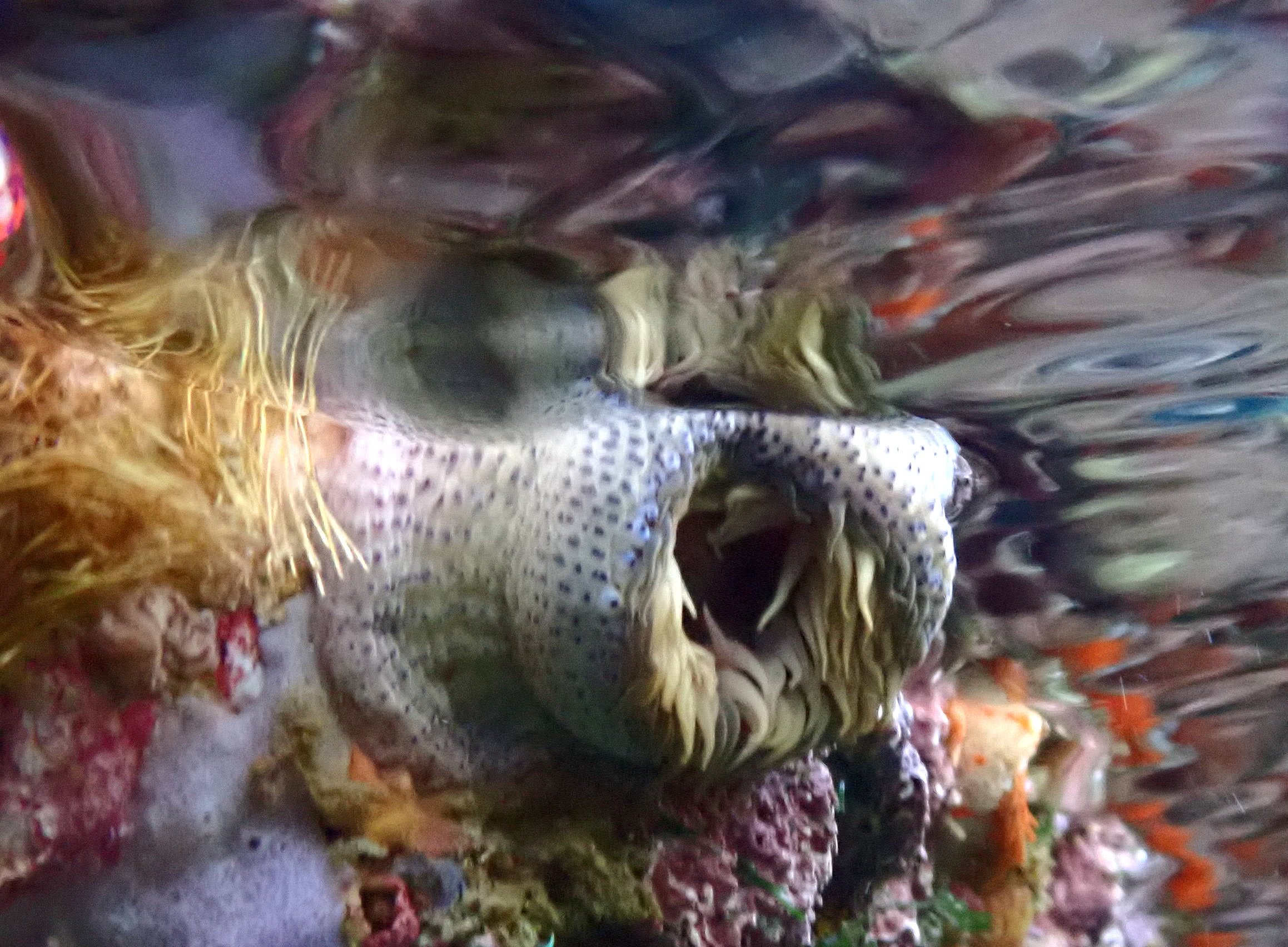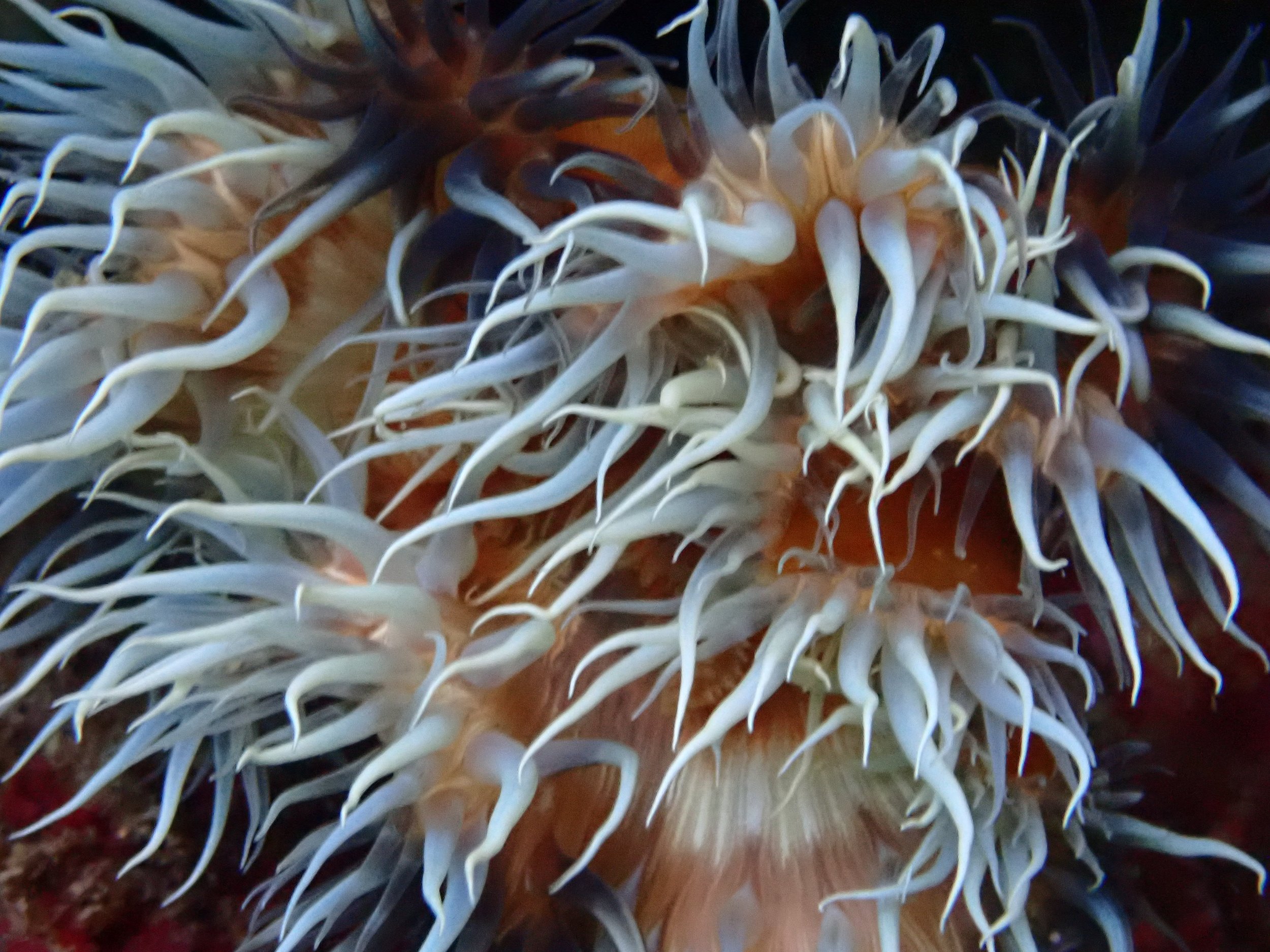SPELLBOUND
Stories can spark a nature-awakening as we confront the climate crisis. Leonie Joubert brings one back from the kelp forest understory, in the amniotic waters of the Atlantic Ocean surrounding Cape Town.
As told at the Two Oceans Aquarium in the winter of 2023.
Chapter 1: Portal
Early in 2021, I got an email from my editor at National Geographic magazine.
Three simple lines.
Leonie, he said, I’ve got another assignment for you. Do you scuba dive? Say yes!
The job? To write a long-form story on Africa’s kelp forests to run alongside the visual narrative by veteran Nat Geo photographer Tom Peschak.
The closest I’d come to diving were a few not terribly successful snorkelling attempts in my youth, which were uncomfortably claustrophobic, but how could I say no? A few weeks later I was a certified free diver and scuba diver.
Tonight’s talk isn’t about the National Geographic story — it only hits the bookstands in 2025, and, no spoilers.
Also, I’m from the LBJ school of nature appreciation — there are little brown jobs and large brown jobs — so this won’t be a check list of all the creatures out there in the briny Atlantic.
In these few moments, as we drift beneath the kelp overstory, I want to reflect on three things:
What it means to be human, at this specific point in the story-arc of our species, as we bring on climate collapse and the sixth mass extinction.
Those of us privileged enough to visit a wilderness as rare and unreachable as this, we have a responsibility to bring back stories of its awe and wonder, to share with those who can’t get here.
And that we humans must de-centre ourselves from the collective story, and give voice to the more-than-humans who don’t speak our primate language, and are invisible from our shared narratives.
The philosopher Alain de Botton says a writer should always travel with a sketchbook in hand. He’s right. It tunes us in to a richer spectrum of experience.
It’s a bit tricky to whip out a sketch book when you’re in the ocean, 5 metres down and being tossed around by the current on a single breath-hold.
Which is where this magic piece of technology comes in: a simple point-and-shoot underwater camera. It’s smart enough that even the most ham-fisted can take a half-way decent photograph if they hit the shutter release enough times.
These images are grainy and unedited. The videos are amateur reels, mixed for small-screen social media. Now, as we reflect on grave and existential matters, we’re going to flick through a writer’s sketchbook from two dive seasons in the kelp.
Chapter 2: Deep freeze
When you go diving in the kelp forests, you have to keep your eyes on the prize, because first you have to get over the discomfort hump.
When you flop into the water, the SHOCK spasms your muscles and steals your breath.
But now you’re committed, so you yield to this muted, thicker, softer medium.
Face down, the hyperventilating gives way to deep, quavering, almost mechanical breaths. Your skin is on FIRE.
But soon the burn gives way to an exhilarating numbness. The vagus nerves in your neck — the superhighway connecting your brain box with your breathing bits — are being cryogenically preserved. For the next little while, there’s no way your nervous system can go Chernobyl on you.
Linear time curls in on itself: your breath is slow, and rhythmic, and steady.
The transition is complete. Now… it’s time to go deep.
VIDEO: For the full immersive experience, take in a deeeeeep breath in, and out. Take another deeeeeeep breath in… let it out half-way… and… get sideswiped by this monster.
Chapter 3: Ka-BOOM!
This is what you might call a ‘barrier to entry’, although I’d throw in a few florid expletives.
Romantic as this ocean wilderness is, not everyone can get here, and not just because it can be a dangerous place.
Very few South Africans live within driving distance of the Cape peninsula, whether they’re in a Jo’burg suburb or on the Cape Flats.
Many South Africans have been dispossessed of their sense of connection with this shared natural heritage, through colonial and apartheid-era exclusion, and the same inequality barriers that still bedevil us today.
The next two stories are about why this matters, and what happens when people overcome this historic exclusion.
VIDEO: To set the scene, this video. It’s grainy, the lighting plays tricks, but nothing captures the cathedral experience of the kelp forest quite like this encounter. It should be called The Ascension.
Chapter 4: Genuflections
Loyiso Dunga is a Xhosa man whose grandfather tethered him to his ancestral connection with the ocean. He grew up in Khayelitsha but had no idea that the kelp forests existed, until he encountered them through photographs on his computer screen as a university student. He was so mesmerised by what he saw, that he simply had to get into the water and see for himself.
Only, he couldn’t swim.
So he took himself off to the UCT swimming pool and, without anyone to coach him, figured out how to get from one end of the pool to the other, and back again. Back and forth, back and forth, until he was ready to pull on some neoprene and learn to dive.
Loyiso’s academic work has contributed to mapping Africa’s kelp forests, which feeds into national policy on how we should manage and protect them. Yet his clinical knowledge of the ecosystem is effervescent with his awe of the ocean. He is becoming one of the kelp forests’ most recognisable ambassadors.
Being in the water with someone like Loyiso is like genuflecting in a hallowed space. Whatever our faith or spiritual roots, we are all children of a cosmology that goes back to our shared hunter-gatherer ancestors. Our world view was entwined with Nature, we were part of Nature, not separate from it. The echos of these old ways are burned into our DNA, and they re-awaken in these wilderness moments.
Being in the kelp forests feels even more ancient than that, though. It’s like being back in the amniotic waters of this planet, the place where all life was born 3.7 billion years ago.
VIDEO: This is where the mindbending alchemy of physics turns the underneath of the water’s surface into a quicksilver sky.
Chapter 5: Quicksilver skies
Aanyiah Omardien describes herself as a Brown woman of slave heritage. She has worked for years in coastal education and citizen science, and took me game spotting in the kelp. She tells us how invaluable tidal pools are within the Marine Protected Area around the Cape peninsula, both natural pools, and built pools.
Not everyone can get out into the kelp canopy themselves. Many people don’t have the confidence, or the swimming skill, or the gear to snorkel 10 or 20 metres from shore, let alone dive down to the forest understory.
Tidal pools are safe spaces where people can go with minimal gear, feel safe and be protected from the formidable power of the ocean. Here, they can glimpse some of the forests’ wonders.
Aanyiah’s story is a reminder that we need to coddle these pools, to keep them pristine, free from pollution, chemical or harsh mechanical cleaning, and any unnecessary disturbance. They are the nursery pools for learning about this rare wilderness.
VIDEO: Pink Floyd fans, your moment of Zen.
Chapter 6: Inner sanctum
Red Romans are coy creatures. They don’t like tourists shoving a camera in their face, which might be why many of my Roman photos are blurry rump-shots. But if you can hold still long enough, they just can’t help themselves. They’ll swing around and before you know it, they’ll be eyeballing you right back.
The best place to hang with Red Romans is at Castle Rock.
Castle Rock is the Notre Dame of the kelp forests. It is teeming with life.
This is starkly different to Miller’s Point, which is just tens of meters away.
Both are in the Marine Protected Area, but Miller’s is a ‘take-zone’, so its a hub for recreational fishing.
Castle Rock is a ‘no-take zone’, meaning there’s no fishing or harvesting allowed at all.
Miller’s is like a desert, compared with Castle Rock.
A year ago, SANParks released the results of a biodiversity survey done across the Table Mountain National Park Marine Protected Area (MPA).
One of its most important findings? Just how central no-take zones like Castle Rock are for the conservation and recovery of kelp forest life, particularly because they replenish life in the surrounding waters. This spill-over effect is why recreational fishers can keep playing about in places like Miller’s.
The policy recommendation from this is not only do we need to keep the no-take zones in place, but that we should consider having more of them.
Chapter 7: Original aquanauts
In May 2022, the dive community was abuzz. There was a bloom of jellyfish-type creatures at Castle Rock, but no one knew what they were. My dive buddy and I happened to be in the water during this window. We had no idea we were frolicking with a new species of Ocyropsis, something confirmed by a marine biologist at the Two Oceans Aquarium.
The photographs and observations that came from the dive community during that week are a wonderful example of the citizen science that happens in this MPA all the time, because nature enthusiasts are paying attention and are in a two-way exchange with scientists and conservationists.
Chapter 8: Where the unstoppable force meets the immovable object
The tideline is where the unstoppable force meets the immovable object. Right there, in front of us, the forces of nature are at work, reminding us that we live within the physical constraints of the material world.
The ocean and atmosphere are one system.
In the past 300 years, the ocean has mopped up 30 percent of our carbon pollution, and 90 percent of our industrial-era heat pollution. Now it’s coming to a boil.
This restless seam, where air meets ocean, is a reminder that climate collapse is a reality. It’s not about ideology or belief system. These are the laws of physics at work. It’s like gravity: we don’t have to believe in gravity, gravity still has a hold on us.
We aren’t fighting to save the planet; we’re not just fighting to save ourselves; we’re fighting to save all the life that we share this planet with.
Life will continue, once we’ve gone. But within our lifetimes there will be magnitudes of suffering that are unimaginable.
Chapter 9: It’s not about the viz
Divers always talk about the visibility. But we know it’s not about the viz.
The kelp forest assignment arrived just in the nick of time, because the climate truth bomb had hit:
Realising that in the 50 short years that I’ve been alive, more than half of the carbon pollution driving climate collapse has been dumped into the atmosphere-ocean system.
That I’ve spent 20 of those years writing about it, trying to add a small voice to the global collective so we can wake up from our coma of denial and avoidance, and yet the situation is only getting worse, and far faster than anyone expected.
And now we’re told that we have ten years to slow the collapse.
That’s one decade; ten birthdays; 130 full moons.
The enormity of this broke my brain.
Being able to escape into the kelp forests is helping to put my brain back together again. With each dive, there’s a shift in perspective that is bigger and wider than can be explained by the mere change of sensory experience.
Chapter 10: The Overview Effect
Earth Rising has to be one of the most important images in the history of our species. It was taken in 1968 by Apollo 8 astronaut Bill Anders. It captures the shift in perspective that astronauts call ‘the Overview Effect’: the moment when they leave Earth’s atmosphere, see the planet drifting in the darkness of space, and realise that this is home. This is our only home.
But, to quote the novelist Richard Powers, in the past few generations we have turned half of this planet into a factory farm for just one species.
Human beings need a collective Overview Effect to stop this predatory, suicidal growth.
There are a few ways to spark an Overview Effect. One way is space travel. Psychedelics can do it too - there are even a few university studies to confirm the anecdotal evidence. Nature-bathing is another way: spending time on mountains, in forests, floating in water. But these experiences are often limited to the privileged few.
There is another way, though. It’s simple. It’s ancient. And it’s something each of us is uniquely skilled to do.
Storytelling.
Storytelling is one of humanity’s oldest technologies. Writers and thinkers like Margaret Atwood, Yoval Noah Harari, Jeremy Lent, Amitav Ghosh, Ursula le Guin, Robert MacFarlane, they remind us that this is how we’ve organised ourselves for 200,000 years. It’s how we’ve share values, agreed on social norms, and passed on knowledge. We’ve used storytelling to beat the plough shear into sword, and sword into plough shear. We’ve wielded this technology for great good, and for terrible harm.
More recently, storytelling has convinced us that we’re selfish, individualistic, and competitive; that we’re masters of Nature, which we can exploit, dominate and control. But this is new in the narrative arc of our species.
Storytelling can tap into an older, deeper, wiser world view. It can reach into that part of our brains, and our humanity, that’s hardwired for connection, compassion, and empathy.
We love and care for what we can see and know. But not everyone can see and know what lives in the kelp forests.
Every time I enter the kelp forests, I’m reminded of this. And every time I surface — intoxicated with cold, dopamine, and awe — I have a new sense of urgency. To share these stories; to spark a fever of nature-awakening; to give voice to the otherwise invisible beings that share this remarkable and imperilled planet.
We have one decade to rally; ten birthdays; 130 full moons.
Every second counts.
Earth Rising: Bill Anders (NASA)


























































































